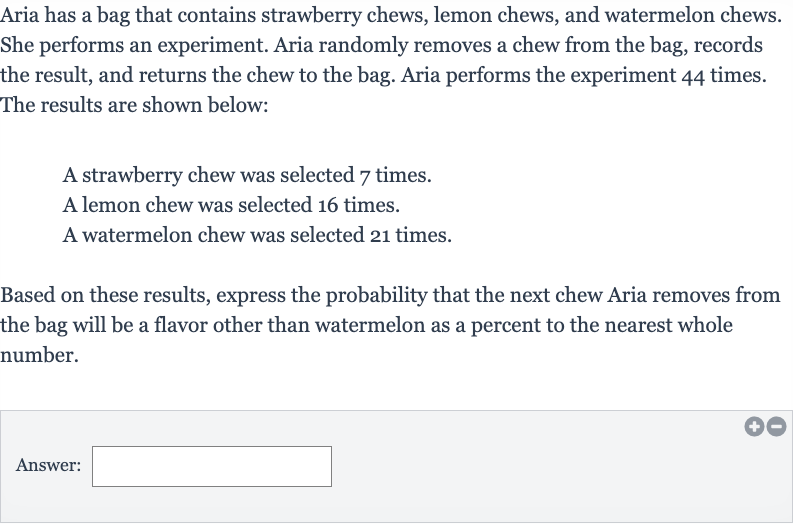AI tutor
Welcome to Bytelearn!
Let’s check out your problem:

Aria has a bag that contains strawberry chews, lemon chews, and watermelon chews. She performs an experiment. Aria randomly removes a chew from the bag, records the result, and returns the chew to the bag. Aria performs the experiment times. The results are shown below:A strawberry chew was selected times.A lemon chew was selected times.A watermelon chew was selected times.Based on these results, express the probability that the next chew Aria removes from the bag will be a flavor other than watermelon as a percent to the nearest whole number.Answer:
Full solution
Q. Aria has a bag that contains strawberry chews, lemon chews, and watermelon chews. She performs an experiment. Aria randomly removes a chew from the bag, records the result, and returns the chew to the bag. Aria performs the experiment times. The results are shown below:A strawberry chew was selected times.A lemon chew was selected times.A watermelon chew was selected times.Based on these results, express the probability that the next chew Aria removes from the bag will be a flavor other than watermelon as a percent to the nearest whole number.Answer:
- Calculate Total Non-Watermelon Selections: To find the probability of selecting a flavor other than watermelon, we first need to determine the total number of times a flavor other than watermelon was selected. This is the sum of the times a strawberry chew and a lemon chew were selected.Calculation: (strawberry) + (lemon) =
- Find Total Number of Experiments: Next, we need to find the total number of experiments to understand the total number of outcomes. This is given as , which is the sum of all the chews selected.Calculation: (strawberry) + (lemon) + (watermelon) =
- Calculate Probability of Non-Watermelon Selection: Now, we calculate the probability of selecting a flavor other than watermelon by dividing the number of times a flavor other than watermelon was selected by the total number of experiments.Calculation: Probability =
- Convert Probability to Percentage: To express this probability as a percentage, we multiply the fraction by . Calculation:
- Round to Nearest Whole Number: Finally, we round the result to the nearest whole number to get the percentage.Calculation:
More problems from Experimental probability
QuestionGet tutor help
QuestionGet tutor help
QuestionGet tutor help
QuestionGet tutor help
QuestionGet tutor help
QuestionGet tutor help
QuestionGet tutor help
QuestionGet tutor help
QuestionGet tutor help
